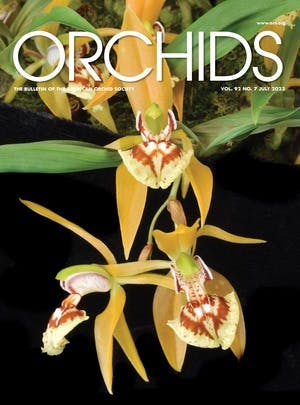
This is quite different from your other garden plants that grow in soil, which holds nutrients for easy uptake. You often read that you should fertilize your orchids weakly weekly, perhaps because it is an easy adage to remember. How much fertilizer should you apply to your orchids? Well, it’s complicated, and there are many factors to consider.
ARE YOUR ORCHIDS IN ACTIVE GROWTH?
Most orchids accelerate their growth rate when the days lengthen, and the sun intensity increases in the spring. Your goal is to match the fertilizer application rate to the growth rate, so the availability of nutrients is not a limiting factor. Many, but by no means all, orchids rest during the winter months. Most cattleyas do not require much, if any, fertilizer in winter. The winter-dormant orchids, such as habenarias and catasetums, should be kept mostly dry, with no water or fertilizer in winter. The soft cane dendrobiums like a coolish, dryish winter with occasional waterings but no fertilizer, which would encourage the formation of keikis rather than flowers. Alternatively, phalaenopsis continue growing in winter and should be fertilized, albeit at a lower rate.
WHAT MEDIA ARE YOU USING?
Sphagnum moss and peat-based mixes such as Pro-Mix tend to hold fertilizer salts more tightly than coarse or inorganic media, so salts can build up in the mix. The nature of the mix makes it very difficult to flush, so more dilute fertilizer should be used with salt-retentive media. Organic media such as bark will hold onto some nutrients, which can be absorbed over time by the orchid. Many orchid books recommend a high-nitrogen fertilizer such as 30-10-10 be used with bark-based mixes, but this has the unintended impact of hastening the degradation of the bark by the microbial population that feeds on the extra nitrogen. Inorganic mixes such as clay pebbles and charcoal may adsorb salts onto their surface, but they are generally not available to the plant later.
HOW MANY SOLUBLE SALTS ARE IN YOUR WATER?
If you notice lots of white hard water deposits on your plant leaves, you likely have hard water. This type of water tends to be alkaline, has plenty of calcium though maybe not much magnesium, and, over time, can increase the pH around the root zone of your orchids, leading to nutrient deficiencies. This water also tends to be high in soluble salts, and the addition of fertilizer, which is basically another salt, just increases the salt content of the water. The conventional wisdom is to try to minimize fertilizer additions to prevent salt toxicity, although the different salts can compete for uptake, so you may actually have to increase fertilizer rates in order for the plant to receive enough of each of the nutrients it requires. If you have pure water, such as rainwater or reverse osmosis water, you have the opposite situation. You must supply all the nutrients to your plants. If you have tap water, you are likely somewhere between these extremes.
[1] Try to balance the competing air and moisture needs by blending together different materials. For a mix that provides some nutrient retention while providing airy open pore spaces for the roots, try something like the St. Augustine Orchid Society coarse mix, which contains about 30% bark, 30% coarse perlite, 30% clay pebbles, and 10% charcoal.

[2] Vandas are heavy feeders. You can spray the roots several times a day with dilute fertilzer solutions to supply all the mineral nutrition they need to flower well.

HOW OFTEN DO YOU FERTILIZE?
Many orchid books recommend you fertilize weekly, flushing with plain water monthly, or fertilize every other time you water, flushing with plain water in between. Some orchid growers and many commercial growers use continuous liquid feed. They fertilize with a dilute solution each time they water their orchids. Dilute solutions more frequently seem to be closer to the natural environment in which epiphytic orchids evolved. If you only fertilize once a month, you should apply fertilizer at a higher concentration than if you would if you fertilize more regularly, recognizing that much of the fertilizer will drain through the bottom of the pot.
ARE YOUR ORCHIDS HEAVY FEEDERS?
Vandas and cymbidiums tend to be heavy feeders, desiring more fertilizer than light feeders such as cattleyas. The drought-enduring orchids grow more slowly than many other plants because they use the CAM photosynthesis pathway. They keep their stomata closed during the day to limit water loss and open them at night to absorb carbon dioxide that is stored until daylight when photosynthesis begins. This adaptation allows them to endure drought, but it requires the expenditure of extra energy, so they grow more slowly than their counterparts that absorb carbon dioxide and photosynthesize concurrently.
HOW DO YOU CHOOSE A FERTILIZER?
The purpose of fertilizer is to supply your plants with the building blocks they need as they harvest energy from the sun to produce new growths and flowers. Some of these building blocks, such as calcium, magnesium and micronutrients, may be naturally present in your water, unless you are using a pure water source like rainwater. Some water-soluble fertilizers contain calcium and magnesium, and others do not, and even those with calcium and magnesium may not have enough. You should select a fertilizer that is best for your water quality.
In the St. Augustine area, well water is less than desirable because it contains a high level of dissolved salts, with lots of calcium bicarbonate. This high salt content can also limit the types of orchids that will grow well, which is one of the reasons many growers have switched to using rainwater for their orchids. Table 1 provides some fertilizer suggestions for the water typical in our area.
Table 1. Some suggested fertilizer formulations for various water sources in Florida. If unsure of your water quality, have your water tested..

HOW DO YOU BALANCE THESE FACTORS?
You have to decide how much fertilizer to give your plants. Many of us have mixed collections of orchids and it is impractical to use one fertilization rate for one group and a different rate for another. Instead, select an application rate that is suitable for all your orchids, perhaps ¼ to ½ teaspoon per gallon weekly in summer and ⅛ to ¼ teaspoon per gallon weekly in winter. If you water twice as often in summer as in winter, you will be supplying twice the fertilizer to your plants even before adjusting your application rate.
Even better is using a dilute fertilizer with every watering, so you can match the nutrient demand to the orchid’s growth rate. Most people make this decision based on the nitrogen content, the first number in the fertilizer formula, although the levels of calcium and magnesium are also important for your plant’s health. For my mixed collection of orchids using reverse osmosis water, I try to provide 60 ppm nitrogen, 50 ppm calcium and 20 ppm magnesium in summer with every watering, and 40 ppm nitrogen, 30 ppm calcium, and 15 ppm magnesium in winter. With my RO water, I must add calcium nitrate and magnesium sulfate supplements in addition to fertilizer to get to the desired concentrations.
You can also supplement heavy feeders with some time-release fertilizer. Blend in some time-release fertilizer with your potting mix when repotting your catasetums, or top dress your spring blooming phals in the fall to encourage blooming.
Orchids are efficient scavengers of nutrients. In their natural environment, mineral nutrients are rare, so orchids have evolved to absorb every atom they encounter. Overfertilizing your orchids means you are giving them more fertilizer than they can use efficiently given the amount of light, air and temperatures they are exposed to. If you supply too much fertilizer to your plants, you run the risk of having lush, soft growth that is more easily attacked by pests and diseases. Plants grown with less fertilizer perhaps will not grow as fast, but should be stronger and more resistant to problems.
Table 2. Nitrogen, calcium and magnesium concentrations in ppm as a function of application rate for selected fertilizers.

Fertilizer is less important than many other aspects of orchid growing. The legendary Rebecca Northen wrote that beginners should not fertilize at all, they should master the elements of light, temperature, air, and watering first, and only then start fertilizing their orchids. Dave Off of Waldor Orchids, who grows the most immaculate mature cattleyas, says they do not fertilize their orchids except after repotting when they are topdressed with some time-release fertilizer. Start your fertilizer program at a quarter or eighth strength for a growing season, after which you can decide if more or less fertilizer is better under your growing conditions.
— Sue Bottom started growing orchids in Houston in the mid–1990s after her husband Terry built her first greenhouse. They settled into St. Augustine, Florida, Sue with her orchids and Terry with his camera and are active in the St. Augustine Orchid Society, maintaining the Society’s website and publishing its monthly newsletter. Sue is also a member of the AOS Editorial Board (email: sbottom15@gmail.com).











